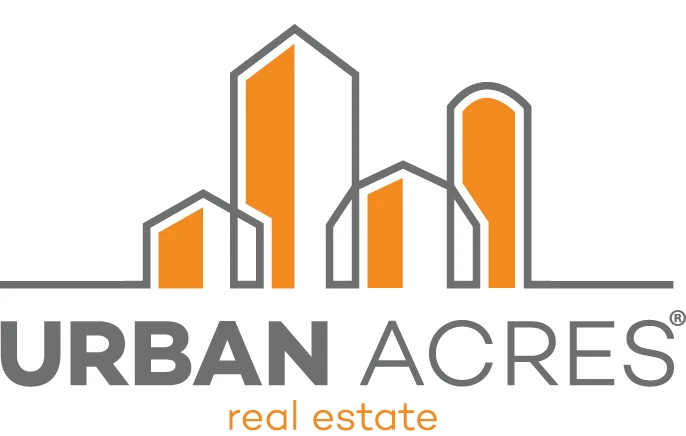When you’re house hunting, an inviting deck can be the feature that seals the deal. Stepping out onto a well-designed outdoor space that overlooks a backyard made for summer cookouts and cozy fall gatherings? That’s what dreams are made of!
But if you’re like most homeowners, you probably don’t think much about the deck material—until it’s time to maintain or replace it. Then you’re facing a decision that can impact your wallet, your weekends, and your home value.
How do I choose between a composite deck and wood deck?
This has become one of the most common questions we hear from clients. It might come up when you’re looking at homes with aging wood decks that need TLC or considering adding a deck to a property without one. Or maybe the house you bought a few years ago has a deck that’s seen better days, and you’re wondering whether to repair or replace it.
Some people love the deck maintenance ritual. Others would rather spend their weekends relaxing on the deck, not maintaining it. We’ve seen how the right deck choice enhances both your daily living and long-term home value.
Let’s review your options so you can make the right choice for your lifestyle!
Understanding Your Decking Options
When it comes to decking materials, you’ve got two main options: composite and traditional wood. Each has its place in our diverse housing market, from the historic neighborhoods of downtown Iowa City to the newer developments in North Liberty and Coralville.
Composite decking is engineered from a blend of recycled wood fibers and plastic polymers. It’s like the hybrid car of decking materials, combining the best aspects of both components while minimizing the downsides. Modern composite boards come in dozens of colors and textures that mimic real wood grain.
Wood decking remains the classic choice, with options ranging from budget-friendly pressure-treated lumber to premium cedar and exotic hardwoods. Many people love authentic wood—the natural grain patterns and the way it weathers over time.
If only the Iowa climate had a milder personality! Temperature swings of 100+ degrees between our hottest summer days and coldest winter nights, plus high humidity, sudden storms, and spring freeze-thaw cycles, can wreak havoc on outdoor structures like decks.
Composite Decking: A Modern Solution
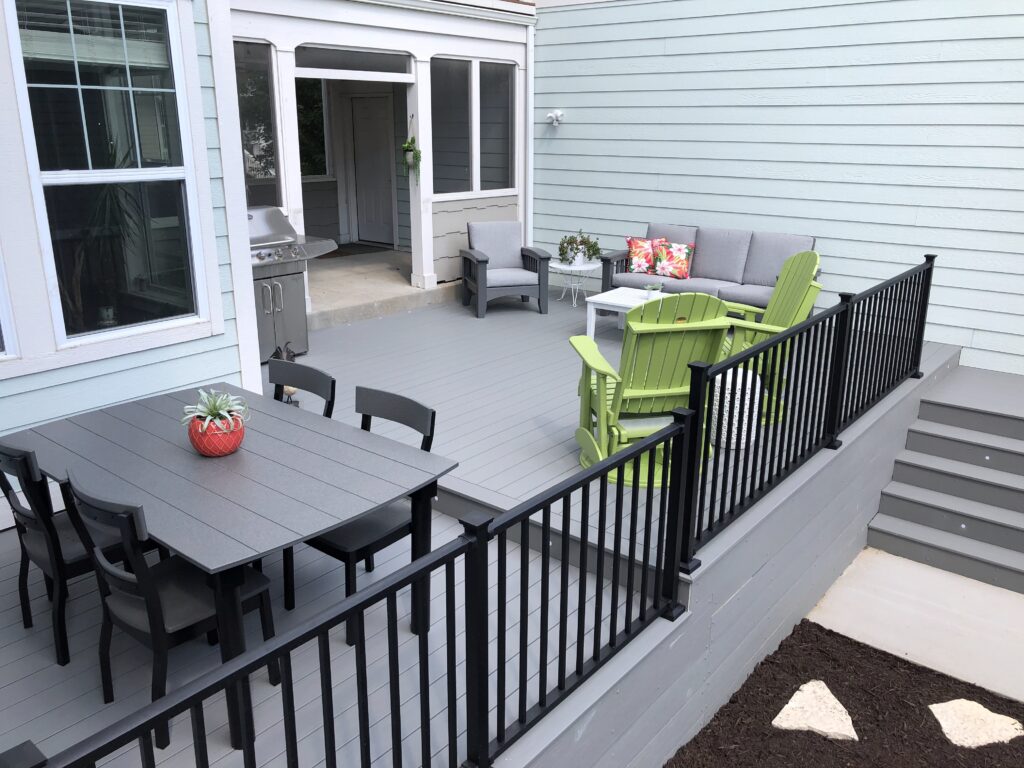
The Upsides of Composite Decks
Virtually Maintenance-Free Living
The biggest selling point for composite decking is the freedom it gives you. While your neighbors spend their weekends power-washing, staining, and sealing their wood, you can enjoy your outdoor space, a cold drink in hand.
A simple soap-and-water cleaning once or twice a year is usually all that’s needed to keep composite looking fresh.
Built for Iowa Weather
Composite materials excel in our temperamental climate. They won’t warp, crack, or split during those dramatic temperature swings from 95-degree July days to -15-degree January nights.
The material also resists absorbing moisture, so it won’t expand and contract as much as wood during humid summers and dry winters.
Safety and Comfort
Wood decks can be a literal pain for families with young children who love to run around barefoot. Composite eliminates the splinter risk that comes with wood.
Many composite products also stay cooler underfoot than traditional wood, though they still get quite warm during the peak of summer.
Longevity That Pays Off
Most composite decking comes with warranties ranging from 15 to 30+ years. Many products maintain their appearance for decades with minimal care.
When your home’s on the market, this can be a major selling point for buyers looking to avoid deck maintenance.
Eco-Friendly Options
Many composite products include recycled materials to appeal to environmentally conscious homeowners. Your deck gives new life to materials that might otherwise end up in the landfill.
Downsides to Consider
Higher Upfront Investment
Quality composite decking costs 25 to 50% more than comparable wood options. For a typical 400-square-foot deck, you might pay between $16,000 and $32,000 for materials and installation.
Heat Retention
During Iowa’s hottest summer days, composite decking can become too hot to walk on barefoot. Dark-colored composites are particularly prone to this issue, though newer formulations are much cooler.
Repair Limitations
Unlike wood, you can’t easily sand out scratches or stains from composite materials. The boards are durable, but repairing damage can mean replacing entire boards.
The Synthetic Look
Some homeowners prefer the look and feel of real wood. While composite manufacturers have made huge strides in creating realistic wood-grain textures, purists can still usually tell the difference.
Wood Decking: A Classic Choice
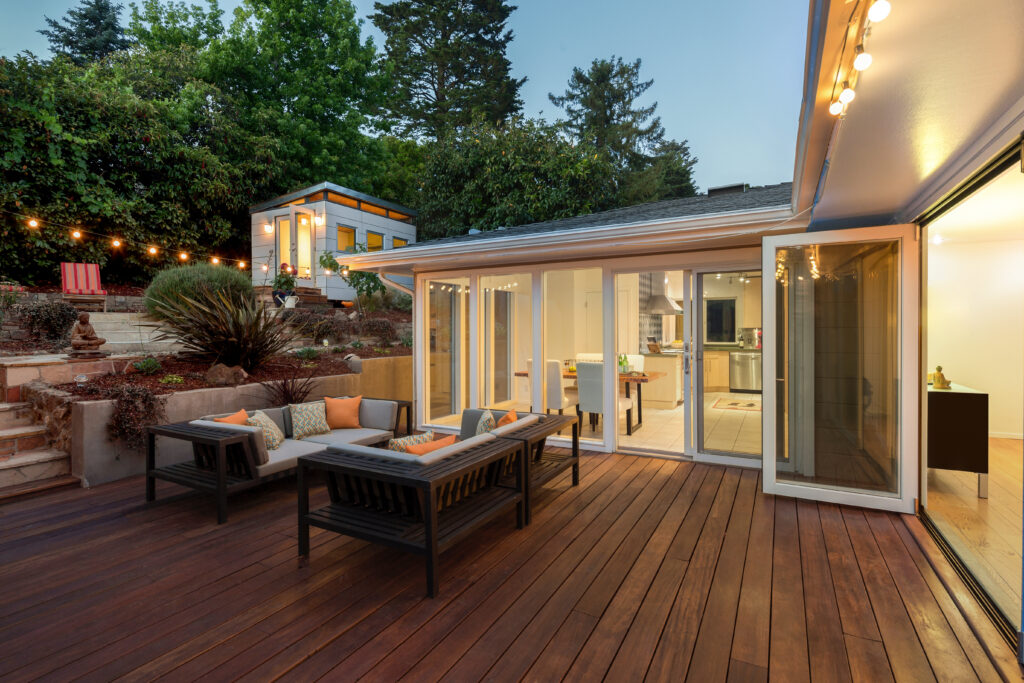
The Upsides of Wood Decks
Unmatched Natural Beauty
Wood has been the go-to decking material for generations. Each board has unique grain patterns, and the way wood ages and develops character appeals to many people. Cedar, in particular, offers beautiful color variations and natural weather resistance.
Budget-Friendly Entry Point
Pressure-treated lumber is one of the most affordable decking options, making it accessible for first-time homeowners and those working with tighter budgets.
While the cost per square foot installed on a composite deck averages $40 to $80, a wood deck is more in the ballpark of $25 to $50.
Easy Repairs and Modifications
When wood boards get damaged, replacement is straightforward and inexpensive. You can also easily modify wood decks, so if you want to cut new openings, add built-in features, or make repairs, you don’t need special tools or expertise.
Customization Freedom
Wood absorbs stains and paints, allowing you to change your deck’s appearance. Want to go from natural cedar to a bold blue that matches your newly painted shutters? Wood makes that possible.
Traditional Appeal
In a traditional neighborhood, wood decking often complements the home’s architectural style better than synthetic alternatives. Many homeowners feel that wood fits better with their older homes.
Downsides to Consider
Maintenance Demands
Wood decking in Iowa requires annual attention. This typically means power-washing in the spring, followed by staining or sealing every 1 to 2 years. Skipping these steps can lead to rapid deterioration, especially in our area.
Weather Vulnerability
Wood decks clash with harsh weather. The combination of UV exposure, moisture, and temperature extremes can cause warping and cracking. Wood is also more susceptible to insect damage and rot if not maintained.
Shorter Lifespan
Even with excellent maintenance, you usually need to replace wood sooner than composite alternatives. Pressure-treated lumber might last 15 to 20 years with good care, while cedar can last 25+ years if you’re proactive with maintenance.
Safety Concerns
Wood decks splinter over time, and weathered wood becomes slippery when wet. This is a real concern during Iowa’s humid summers and after sudden storms.
How Iowa’s Climate Affects Your Choice

We deal with some serious weather extremes in Iowa. If you want to keep your deck looking great, you can’t ignore what’s going on outside your window.
Spring Freezing and Thawing
When water gets into cracks or grain patterns and then freezes, it expands and can cause major damage. Composite materials generally handle this better than wood, but proper installation and drainage are key for both materials.
Summer Heat and Humidity
Heat and humidity are constant companions during Iowa summers. It’s the perfect recipe for expanding, warping, and cracking wood. Composite materials resist these moisture-related issues, but can become hot to the touch.
Storm Damage
We often think about roofing and siding when storms roll through, but your decking can also take a major hit from hail and straight-line winds. Wood may be easier to repair after storm damage, but composite materials are generally more resistant
UV Exposure
The hot Iowa sun is brutal. Wood requires regular staining to prevent UV damage, while early-generation composite materials were prone to fading. The good news: Newer products have mostly resolved this issue.
Maintenance Guide for Current Deck Owners
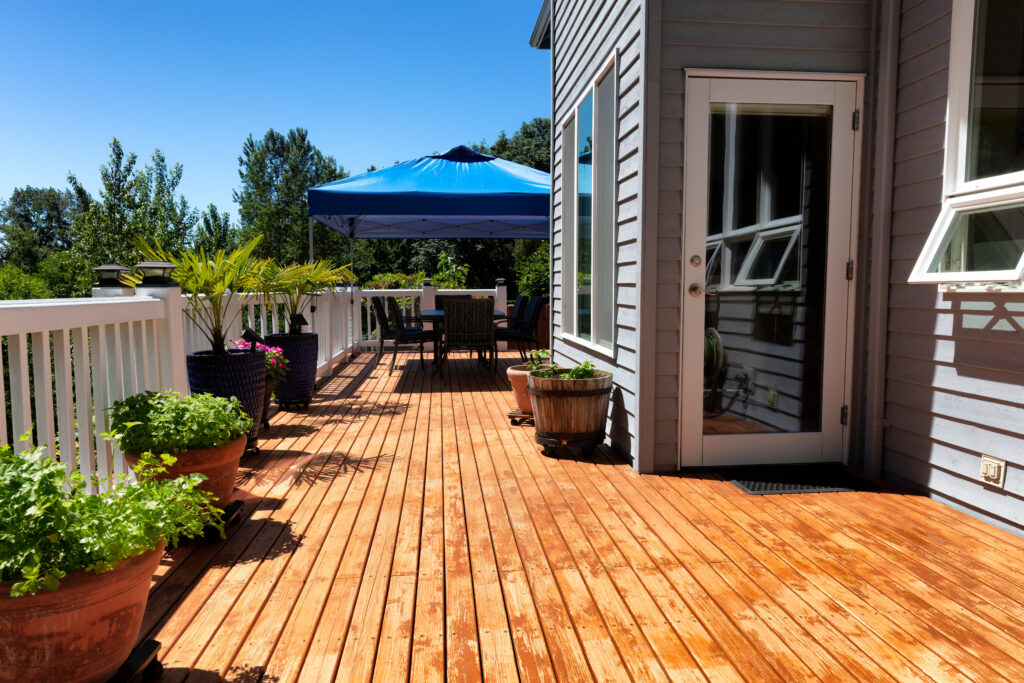
So, what if you already have a deck that’s in good shape? We’ve created this cheat sheet to help you keep it in top shape.
Caring for Your Composite Deck
Spring Preparation (March-April)
Start your season with a thorough inspection. Look for any boards that may have shifted during winter freeze-thaw cycles and check that drainage is working properly. Clean off any winter debris.
Regular Cleaning
Mix warm water with a mild dish soap for routine cleaning. Use a soft-bristle brush for stubborn dirt or mildew. For tougher stains, get a specialized composite deck cleaner available at most local home improvement stores.
Dealing with Stains
Act quickly on spills, especially grease or oil. For food stains, try warm, soapy water first. For more stubborn stains, a paste made from baking soda and water often works. Avoid harsh chemicals or pressure washing at high settings, which can damage your surface texture.
Seasonal Maintenance
Remove snow promptly using a plastic shovel. Keep drainage areas clear of leaves and debris. Check that your furniture pads are in good condition to prevent scratching on your deck.
When to Call in the Professionals
If you notice loose boards, structural issues, or damage that affects multiple boards, it’s time to call a deck professional. Most composite manufacturers also recommend professional inspections every few years to maintain your warranty coverage.
Caring for Your Wood Deck
Annual Deep Cleaning (April-May)
Start by cleaning your deck. Use a deck cleaner specifically designed for your wood type, followed by a gentle pressure washing (or scrubbing with a stiff brush). Allow it to dry completely.
Staining and Sealing
Most wood decks need to be stained every 1 to 2 years in the Midwest. Cedar might stretch to 2 to 3 years with quality stain, while pressure-treated lumber typically needs annual attention. Choose stains rated for our local climate.
Seasonal Inspection Checklist
Check for loose boards, protruding nails, and signs of rot or insect damage. Look for areas where water pools—these areas are prone to problems. Replace any damaged boards promptly to prevent issues from spreading.
Winter Preparation
Before winter, make sure your deck is clean and dry. Clear drainage areas and remove or store furniture. Consider applying a winter protectant if your stain manufacturer recommends it.
Repair and Replacement
Address small issues fast. A loose board can become a major structural problem if you ignore it. Sand and re-stain high-wear areas as needed, and keep extra boards and stain on hand for repairs.
When to Call in the Professionals
Many people maintain their own wood decks, but professional staining every few years is a good idea. Professional services cost between $3 and $6 per square foot on average, but they can extend the life of your deck significantly.
Key Questions to Consider
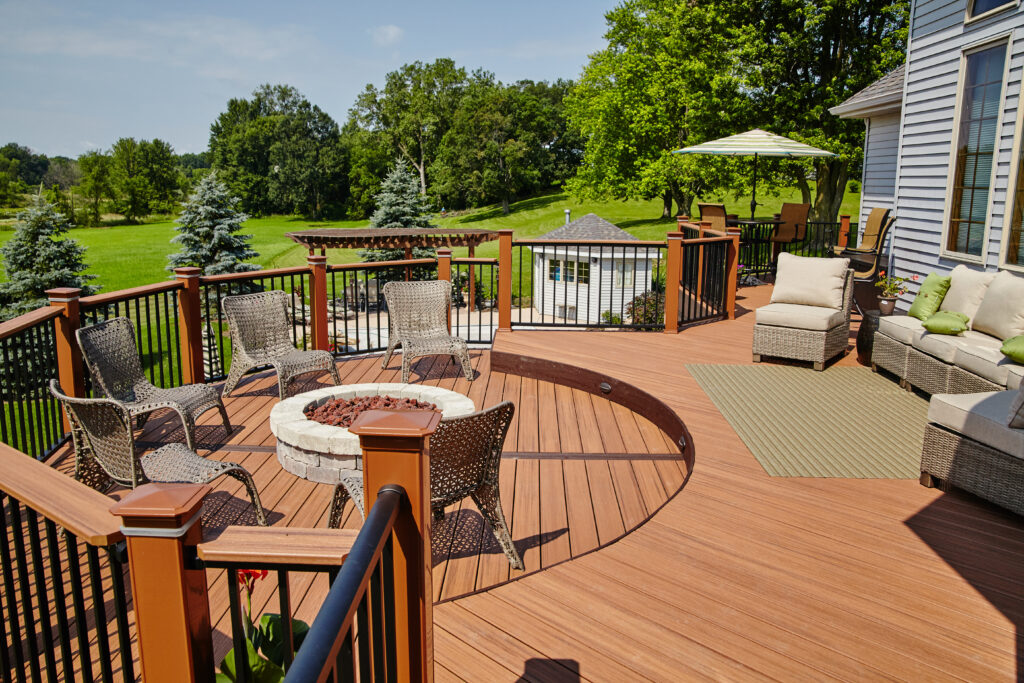
Before you commit to either option, ask yourself these questions:
- What’s your maintenance personality? If you love weekend projects and don’t mind annual maintenance, wood might be perfect. If you’d rather spend weekends lounging, composite is probably worth the extra cost.
- How long do you plan to stay in your home? If you’re planning to sell within 5 to 7 years, the lower upfront cost of wood might make sense. If this is your long-term home, composite’s longevity will likely save you money.
- What’s your budget? Think about the upfront costs and long-term expenses. Sometimes spending more initially saves money over time, but only if you have the cash flow to make it work.
- How do you use your outdoor space? Families with young children might prefer composite’s splinter-free surface, while entertainment-focused homeowners might opt for wood’s traditional warmth and charm.
Considerations for Iowa City Area Homeowners
Seasonal Timing
Plan deck projects for late spring through early fall when the weather is most predictable. Many local contractors book up months in advance during prime building season, so plan early.
Neighborhood Standards
Some Iowa City neighborhoods have informal standards that lean toward traditional materials. Newer subdivisions often embrace modern composite options. Consider what fits your area’s character and your personal preferences.
Local Contractor Availability
Both materials require skilled installation. But finding contractors with experience installing higher-end composite products might take more research. Ask potential contractors about their experience with your chosen material and request references from recent local projects.
Permit Requirements
Check with your local building department about permit requirements. Most deck projects need permits, and the process is often the same regardless of what material you choose.
The Final Verdict on Composite vs. Wood Decking?

TL;DR: Composite decking makes sense if:
- You prefer low maintenance.
- You want long-term durability.
- You don’t mind paying more upfront.
Wood decking is ideal if:
- You love the look and feel of natural materials.
- You enjoy hands-on maintenance projects.
- You’re working within a tighter initial budget.
Whatever option you choose, you want to go with quality materials, ensure proper installation, and maintain your deck based on the manufacturer recommendations. Cutting corners can lead to expensive issues down the road.
At Urban Acres, we’ve seen how the right outdoor spaces can transform your home. Whether you’re considering a deck upgrade for your current home or evaluating properties with existing decks, we’re here to help you make a decision that works for your lifestyle and budget.
Need help finding a home with an outdoor space that fits your vibe? Reach out and let’s start house hunting!

